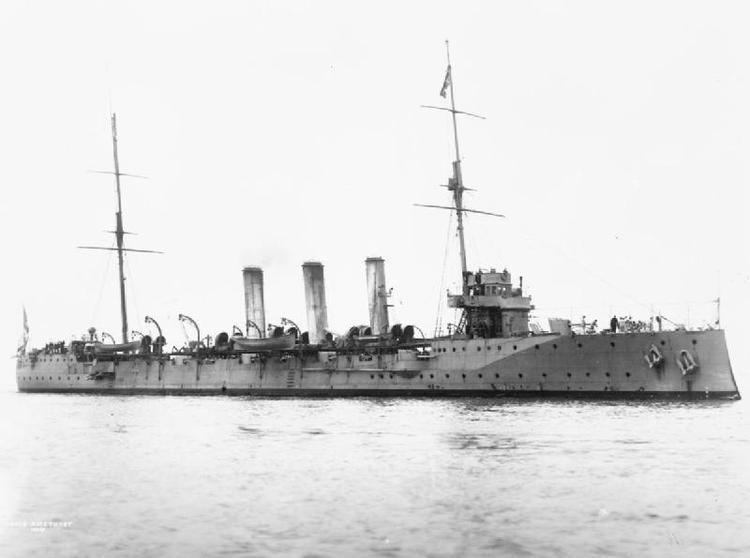Succeeded by None Built 1903–05 | Preceded by Pelorus class In commission 1905–21 | |
 | ||
The Topaze-class (often referred to as the Gem-class) cruisers were a quartet of third-class protected cruisers built for the Royal Navy in the first decade of the 20th century. Four additional ships of the class were cancelled before their keels were laid. They were the last class of protected cruisers built for the Royal Navy.
Design and description
Discussions had been ongoing for several years about a successor to the previous Pelorus class before the Admiralty decided on a design in 1901 that was very much larger and faster than the older ships. The Topaze-class ships had a length between perpendiculars of 360 feet (109.7 m), a beam of 40 feet (12.2 m) and a draught of 16 feet (4.9 m). They displaced 3,000 long tons (3,048 t) and their crew consisted of 313 officers and other ranks.
One objective for the Admiralty with these ships was to evaluate steam turbines against traditional triple-expansion steam engines in a ship larger than a destroyer and Amethyst became the first cruiser to be equipped with them. Her three sisters used a pair of 4-cylinder triple-expansion steam engines, each driving one shaft, using steam provided by 10 water-tube boilers. The engines were designed to produce a total of 9,800 indicated horsepower (7,300 kW) which was intended to give a maximum speed of 21.75 knots (40.28 km/h; 25.03 mph). The three ships easily exceeded their designed power and speeds during their sea trials. They carried a maximum of 700 long tons (710 t) of coal which gave them a range of 7,000 nautical miles (13,000 km; 8,100 mi) at 10 knots (19 km/h; 12 mph) and 2,000 nautical miles (3,700 km; 2,300 mi) at 20 knots (37 km/h; 23 mph).
Amethyst was fitted with a Parsons steam turbine set that drove three shafts using the same number of boilers as her sisters. They delivered enough steam to allow the engines to reach 12,000 ihp (8,900 kW) and her designed speed of 22.5 knots (41.7 km/h; 25.9 mph). She also easily exceeded her designed power and speeds during her sea trials, reaching 23.4 knots (43.3 km/h; 26.9 mph) from 14,300 ihp (10,700 kW). The turbine proved to be more economical than the reciprocating engines of her sisters, but less so at slow speeds, only having an endurance of 5,500 nautical miles (10,200 km; 6,300 mi) at 10 knots, but 3,000 nautical miles (5,600 km; 3,500 mi) at 20 knots.
The main armament of the Topaze class consisted of a dozen quick-firing (QF) 4-inch (102 mm) guns. One gun each was mounted on the forecastle and the quarterdeck. The remaining ten guns were placed port and starboard amidships. Their 31-pound (14 kg) shells were fired at a muzzle velocity of 2,335 feet per second (712 m/s). They also carried eight QF 3-pounder Hotchkiss guns and two above water 18-inch (450 mm) torpedo tubes. The ships' protective deck armour ranged in thickness from .75 to 2 inches (19 to 51 mm). The main guns were fitted with 1-inch (25 mm) gun shields and the conning tower had armour 3 inches (76 mm) thick.
